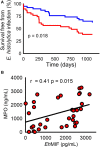Parasite-Produced MIF Cytokine: Role in Immune Evasion, Invasion, and Pathogenesis
- PMID: 31497025
- PMCID: PMC6712082
- DOI: 10.3389/fimmu.2019.01995
Parasite-Produced MIF Cytokine: Role in Immune Evasion, Invasion, and Pathogenesis
Abstract
Protozoan parasites represent a major threat to health and contribute significantly to morbidity and mortality worldwide, especially in developing countries. This is further compounded by lack of effective vaccines, drug resistance and toxicity associated with current therapies. Multiple protozoans, including Plasmodium, Entamoeba, Toxoplasma, and Leishmania produce homologs of the cytokine MIF. These parasite MIF homologs are capable of altering the host immune response during infection, and play a role in immune evasion, invasion and pathogenesis. This minireview outlines well-established and emerging literature on the role of parasite MIF homologs in disease, and their potential as targets for therapeutic and preventive interventions.
Keywords: MIF; cytokine; host-parasite interaction; immune evasion; immunopathology; immunotherapeutic target; protozoan parasites.
Figures


Similar articles
-
[Advances in researches on mechanism of macrophage migration inhibitory factor regulating parasite-host immune interaction].Zhongguo Xue Xi Chong Bing Fang Zhi Za Zhi. 2019 Jul 23;31(4):446-449. doi: 10.16250/j.32.1374.2018229. Zhongguo Xue Xi Chong Bing Fang Zhi Za Zhi. 2019. PMID: 31612687 Review. Chinese.
-
Interaction between parasite-encoded JAB1/CSN5 and macrophage migration inhibitory factor proteins attenuates its proinflammatory function.Sci Rep. 2018 Jul 6;8(1):10241. doi: 10.1038/s41598-018-28625-1. Sci Rep. 2018. PMID: 29980718 Free PMC article.
-
Purification of Antibodies Against Entamoeba histolytica MIF and Their Use in Analyzing Human and Mouse Samples.Methods Mol Biol. 2020;2080:237-247. doi: 10.1007/978-1-4939-9936-1_21. Methods Mol Biol. 2020. PMID: 31745886
-
Targeting Parasite-Produced Macrophage Migration Inhibitory Factor as an Antivirulence Strategy With Antibiotic-Antibody Combination to Reduce Tissue Damage.J Infect Dis. 2020 Mar 16;221(7):1185-1193. doi: 10.1093/infdis/jiz579. J Infect Dis. 2020. PMID: 31677380 Free PMC article.
-
Integrative Approaches to Understand the Mastery in Manipulation of Host Cytokine Networks by Protozoan Parasites with Emphasis on Plasmodium and Leishmania Species.Front Immunol. 2018 Feb 23;9:296. doi: 10.3389/fimmu.2018.00296. eCollection 2018. Front Immunol. 2018. PMID: 29527208 Free PMC article. Review.
Cited by
-
A genome-wide association study of neutrophil count in individuals associated to an African continental ancestry group facilitates studies of malaria pathogenesis.Hum Genomics. 2024 Mar 15;18(1):26. doi: 10.1186/s40246-024-00585-w. Hum Genomics. 2024. PMID: 38491524 Free PMC article.
-
Exploratory toxicology studies of 2,3-substituted imidazo[1,2-a]pyridines with antiparasitic and anti-inflammatory properties.Toxicol Res (Camb). 2022 Aug 9;11(5):730-742. doi: 10.1093/toxres/tfac046. eCollection 2022 Oct. Toxicol Res (Camb). 2022. PMID: 36337253 Free PMC article.
-
Unraveling the Complex Interconnection between Specific Inflammatory Signaling Pathways and Mechanisms Involved in HIV-Associated Colorectal Oncogenesis.Cancers (Basel). 2023 Jan 25;15(3):748. doi: 10.3390/cancers15030748. Cancers (Basel). 2023. PMID: 36765706 Free PMC article. Review.
-
The Emerging Role of STING in Insect Innate Immune Responses and Pathogen Evasion Strategies.Front Immunol. 2022 May 10;13:874605. doi: 10.3389/fimmu.2022.874605. eCollection 2022. Front Immunol. 2022. PMID: 35619707 Free PMC article. Review.
-
Atypical Membrane-Anchored Cytokine MIF in a Marine Dinoflagellate.Microorganisms. 2020 Aug 20;8(9):1263. doi: 10.3390/microorganisms8091263. Microorganisms. 2020. PMID: 32825358 Free PMC article.
References
-
- World Health Organization World Malaria Report 2015. (2016). Geneva: World Health Organization.
-
- World Health Organization Control of the leishmaniases. World Health Organ Tech Rep Ser. (2010) xii-xiii, 1-186. - PubMed
Publication types
MeSH terms
Substances
Grants and funding
LinkOut - more resources
Full Text Sources
Miscellaneous

